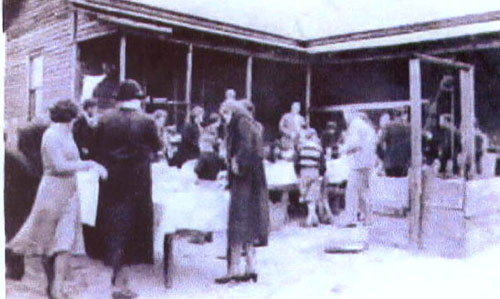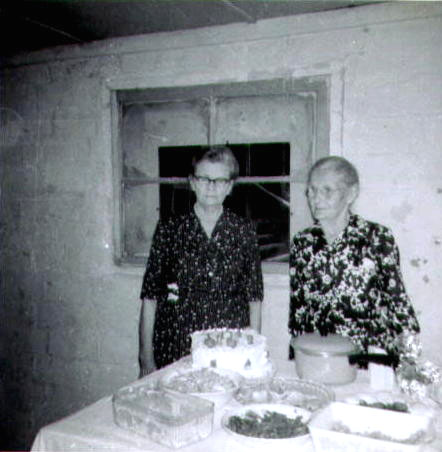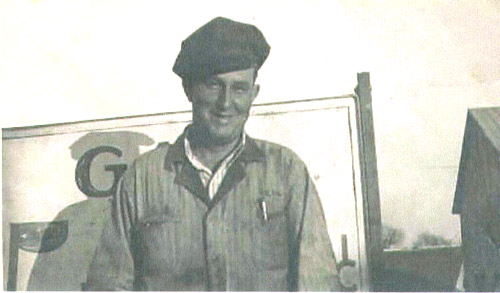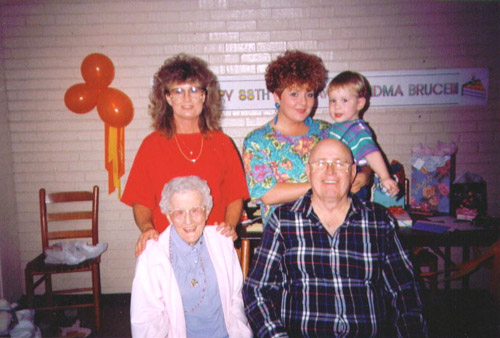
Dock Watson House

Watson family gathering

Mary Teal Burr and her sister, Alene Watson

Fraizer, Buck, Mrs. Alene (85), Junius, and J. D. Watson

Dock Watson Watch Shop

Dock Watson House site today: Rivers Rexall Drug Store (closed)

Bruce Watson

Ruth Watson (Daughter-in-law)

Buck Watson at Super - X Station

Buck Watson at Super - X Station

Ruth Watson Family
Watson Family Stories
The story goes that my great grandfather Watson once owned all the land on the south side of Main Street, all the way down to the creek below Jakie Watson’s house (Indian Creek). My paternal grandfather, Dock Watson, owned most of it, I know. He sold the land for the ice plant. There was a dirt road in front of my Grandparents house. Her house was torn down about five years after the land was sold for the drug store on the corner of the street. That dirt road ran alongside a railroad track. What is now the By-pass (Boulevard) was built using the railroad bed. “Monkey” Teal’s house was just across the street on the east side from my grandparents. Dock Watson’s widow, my Grandmother, Alene Watson, gave the land for the town’s first swimming pool, built in the 1960’s and located a couple blocks south of Main Street near the National Guard Armory. (The pool is not in use today.) I was born in 1934 and can remember regular Sunday afternoon visits to my Grandmother’s house as early as 1938. I was fascinated each Sunday when a train would come by in late afternoon. That train engine looked enormous to me! Another special thing occurred on those Sunday afternoons. My Grandfather would ask my Grandmother, Alene Watson, to prepare an ice cream recipe. Then he would go over to the ice plant and hold the bottom of a deep pan containing the recipe in the super-cold water running through a trough at the ice plant to freeze the ice cream. What a treat! When peaches or strawberries were not in season, we settled on plain vanilla. On Hursey Drive, where I grew up, the neighbors whom I knew were Mary and Charles Pusser and their two real precious little boys names Rouse and Ellison; Estelle Eddins: Jack and Frances Eddins and eventually their 3 pretty little girls named Jackie, Judy, and Jane; Sara Shealy (Tommy Shealy’s mother), Sheriff “Ed” Kirkley and his wife Almyra Kirkley, and their sons “Sonny” and Gene, and daughters Peggy and Tommie. The older son became a teacher and lives in Orangeburg, SC. The younger son became a physician and practices in Hendersonville, NC where he lives. There was a house at 126 Hursey Drive which served as a Methodist parsonage for Friendship Methodist and a couple of other churches out in the country. Jan Stroud, Granddaughter of one of the ministers, became my sister Sue’s close friend. Social life during my teen years: It seemed limited and consisted mostly of: 1) seeing a movie (eventually, Chesterfield’s only movie house closed which meant driving to Cheraw, Wadesboro, or Rockingham to see a movie. 2) Gathering at the “Chat and Chew”, especially after high school ball games. The Chat and Chew was located on the lot adjacent to the south side of my Grandmother Watson’s house. If you were on good terms with the African-American lady named Estelle who worked there as a cook you could get a “Murvin Burger”, named for her son, Murvin. 3) Going to the “hut” in Craig Park one night of the week to the Teenage Canteen. Elizabeth Hodge, better known as “Liz” drove from Cheraw and volunteered as our chaperone. Liz felt strongly that recreation should be provided for teenagers. She had one strict rule: If you left the Hut or its porch, you were not allowed to return. (No doubt, her rule prevented many secreted “No-No’s”!) Speaking of Murvin’s mother, Estelle, I remember that she was a cook in the high school cafeteria and was given credit for the best apple cobbler on earth. No one ever seemed to be able to duplicate it in their homes. Could there have been some secret spice as an ingredient? Our local theater served as a gathering place at noon each day for prayer during World War II. Citizens were reminded of the hour by the blowing of the fire siren with three short blasts. Summer employment was scarce in Chesterfield for teens old enough to work and one felt truly privileged if hired to work in the County Auditor’s office. Tom Eddins was the Auditor for as long as anyone living in the 40’s could remember. The office of Auditor is an elected office. The man affectionately called “Uncle Tom” held the office for over 40 years. In fact, other aspirants to the office simply stopped trying to oppose him when election time rolled around. One other quite desirable source of summer employment was in the office of Don Swinney, where summer employees worked at running a little measuring device over aerial photographs of maps of country farm land to measure the acreage. Mr. Swinney made a mistake one summer by hiring both me and my boyfriend, Lafond, to whom I have now been married for 45 years. There were two “Human Institutions” in the Chesterfield School System for a large part of the 20th century. They were, Miss Kathleen Ellis who taught 4th grade and Mrs. Mary Hunley who taught 7th grade math. (It’s uncertain as to whether any students ever knew her first name.) Who, under her supervision, could forget our female Superintendent, Mertin Hursey, who doubled for many years as high school principal? She was extremely strict, and if students got out of hand at ballgames by rebelliously choosing to do a questionable cheer, she only had to stand and show her “mean” look to quite the cheering section. Quite frankly, the student cheering section saw nothing wrong with this cheer but Miss Hursey did: “Go back, go back, go back to the woods, ‘cause you ain’t, you ain’t got the goods. You ain’t got the spirit; you ain’t got the know; you ain’t got the team so go, bulldogs, go!” As a varsity girls’ basketball team player, I recall with enormous respect and love our Coach, “Preacher Clower”, a giant of a man—an unparallel good influence upon the lives of the members of his basketball team as well as the town citizenry. My parents bought an old jalopy for my older brother, Ralph Watson, to drive. Ralph volunteered for the US Navy in 1941 at the age of 17 both to avoid being drafted and to be able to select the branch of service he wanted. Our brother, Ray Watson, then inherited driving rights over “Blue Heaven”. He painted it “Carolina” blue all over and painted the name “Blue Heaven” beneath the rear window. When word was received of the Japanese surrender which ended World War II, townspeople crowded the downtown main street whooping and hollering and waving flags. My aunt, Mary Hammond, owned the only beauty shop in town. On V-J Day (victory in Japan), “Blue Heaven” had joined the festivities. Mary pulled down her patriotic red, white and blue beauty shop curtains and draped them over “Blue Heaven” for the parading and horn-blowing of vehicles which had come to join in the celebration. Even elementary school children took part in the World War II effort. Each Monday morning children would place an order for Victory Stamps. A “delegation” of two students would walk a mile from school to the post office to buy those stamps. Upon the return of the delegation, classroom students would paste the stamps they had purchased into a booklet. A total of $18 worth of stamps would buy a war bond. At maturity, the bond would be worth $25. One almost had to be the “Teacher’s Pet” to have bestowed upon them the honor of walking to the post office. The sale of war bonds was one method utilized by the federal government to finance the cost of World War II. My mother often talked of the depression era and the beloved Negro lady, Nannie Mae Williams, who remained in our family’s employ by her own choice until age 82, related many stories to me of the difficult “Hoover Days.” She was proud to say that her family did not suffer during those days as many others did because her family worked on a farm. She always had a healthy respect for farmers. When I return to Chesterfield to visit family, I am both amazed and comforted by how little the town has changed in over a half century. For example, the little red brick building which housed “Miss Cora Craig’s” is still standing. When one wished to buy from a pretty and varied selection of fabrics and buttons for sewing, one only needed to refer to “Miss Cora Craig’s” and it was understood where you were going and for what purpose. (Editor’s note: that building was torn down when the new Courthouse was built.) My Grandfather, Dock Watson, was a jeweler and he owned jewelry sales and repair shop a few doors west of the theater in the 1930’s and perhaps on into the early 40’s. A section of the northwest side of Main Street from the theater to the Wadesboro highway was under a shelter—an actual covering. On the south side of the street, only a couple of stores had covered sidewalks, they included the shoe repair shop and a beauty shop. Perhaps at a date before I can remember, all the sidewalks on both sides of the street were sheltered. Main Street’s business district was so limited; it wouldn’t require an enormous amount of shelter. In fact, folks used to half-jokingly say Chesterfield was so small that if you blinked your eyes while driving through, you’d miss seeing it. There were no stop lights anywhere, even on the by-pass. It was taboo to hang around on the streets, and the socially correct town folks would never have done so. Persons could be classified as either “town” or “country” people; therefore, if one hung around on the streets on Saturday, it was assumed that person had come in from the “country” to buy weekly groceries, farm supplies, or other necessities and to socialize on the streets. Racial segregation forbade “colored” folks from loafing on Main Street and they were more or less exiled to the back lots behind the business establishments to congregate. Respectable white young people never ventured into the back lots. Even today as a senior citizen, I do not know what went on in the back lots. Occasionally one would hear of a bad fight or a knifing which sent a man or woman to the doctor or hospital to be stitched up. (The local doctors were Walter Raphael Wiley, Sr., or Doctors William and Jerry Perry.) The nearest hospitals were Wadesboro or Monroe, NC. Speaking of doctors, there were no medical clinic buildings in town in the 1940’s. The doctors had small offices in town. Dr. Wiley’s office was two rooms with creaky floors upstairs over a local business in the general area of east Main Street near where the Moore’s department store used to be. Dr. Wiley probably did thousands of tonsillectomies on children under the influence of ether as they sat upright in an old leather chair. As an anesthetic, ether was more dreadful than the tonsillectomy! Men exchanged stories of the bad effects on their crops from too much or too little rain, or the high cost of fertilizer and seed. They might be heard to say something such as “Isn’t it bad about old man Brock dying of a heart attack! I hear he left his wife pretty well off, though, and she ought to be OK.” Few country folks subscribed to local newspapers or had the luxury of a telephone; thus, news was commonly spread by word of mouth. National news was followed mostly by listening to the radio or by reading the GRIT weekly news magazine. While the women shopped and the men chatted, children usually enjoyed going to see a move which for a number of years cost only 11 cents. For that dime and a penny, the movie house offered a “serial” and a feature film. Most often the serial was 6 to 8 episodes of a cowboy story featuring such popular western heroes as Buck Jones, Lash LaRue, and the Lone Ranger. Children didn’t want to miss a single episode of the serial, and would gladly endure a love story showing as the feature film in order to see the serial a second time. The theater owners didn’t require the theater to empty its seats between showings; thus, parents could put their children in the theater for babysitting purposes and go about their merry way for an entire afternoon. Parents knew that such an arrangement was safe, because the ticket seller knew all the children and would be alert to an adult “stranger’s” appearance on the scene. One exception was during the time of the pre-World War II maneuvers held in and around Chesterfield when soldiers would use their spare time to see a movie. Even then, parents knew that the theater employee in the ticked booth would keep a close eye out for anything out of the ordinary. [le to bwe] Sources of entertainment were scarce in our very small town as I suppose it was in all small towns. Other than going to the movies and the once-a-week teenage canteen at the “hut” young people were left to their own cleverness and inventiveness to come up with “Something To Do.” The teen age boys would gather and lean on the ledges of the store fronts, especially the old Chesterfield Drug Store operated by Dr. C. E. Braswell to chat and “girl-watch.” No doubt they gossiped also but males never confess to gossiping, do they? Gossiping is supposed to be practiced only by women. A decent girl would go out of her way, cross the street, and walk in front of Belk’s rather than pass in front of that group of boys. After all, she knew they might make who-knows-what sort of comments after she passed. Just before dark one evening, Lafond joined the crowd at the storefront. Charlie Crawford and couple of other older teens came up with a marvelous idea. “Let’s go watermelon stealing!” That activity seemed harmless enough to the younger boy. In reality, watermelon stealing was a crime, but the boys knew that if they were caught, the town’s policeman, Mr. J. W. Bittle, would be more likely to just give them a good “talking to” and send them home. If the thieves got too greedy, the perpetrators might have to pay for the stolen melons, but that would be the extent of the punishment. So, they loaded up in about three carloads and headed out the Wadesboro highway. It was a moonless night. Soon Charlie pulled into a little dirt road between a watermelon patch and a cotton patch. The car occupants went into the watermelon patch where they went about the essential task of thumping melons for ripeness. Suddenly, a voice yelled out, “Who out there is stealing my watermelons?” Immediately following that question, a shotgun let out two big blasts. That sent Lafond and the others running for dear life. They went toward the cars, but no drivers were back at the cars, so they kept running past them, intending to get away to safety across the road. Lafond fell into a ditch as he ran, and his face and body went into mushy, rotting, bad watermelons that had been thrown away by the owner. He hopped up as quickly as he could and headed into the cotton field where he and the other victims of the prank lay low. Soon they calmed down enough to hear the laughter. Charlie Crawford had taken them to his own father’s field and Charlie’s brother who was expecting them, had fired the shotgun into the air. Charlie and his cronies who were in on the prank couldn’t stop laughing. They would run out of breath, their laughter let up for a moment and then start again. The so-called watermelon stealing event had been set-up and designed to scare the daylights out of a few of the younger boys. Charlie picked a couple of watermelons and sliced them on the hood of the car and offered them to the “victims” of the prank. Lafond has been scared so badly that he could hear his heart thumping loudly for such a long time that he could not eat the melon. He had been certain that he was going to die that night. He never again went on a watermelon stealing adventure; not even if invited. The memory was just too disturbing, even after learning that it was just a set-up.